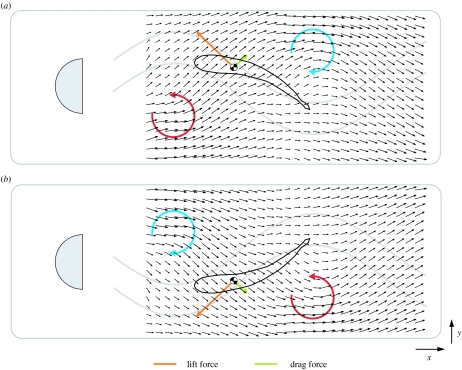Figure 10.
Hypothesized mechanism of vortex capture for thrust production of a fish in a vortex street based on theoretical and experimental work with oscillating foils, live and euthanized fish (see text for details). The direction and length of the black arrows represent flow velocity. (a) A low-pressure, counter-clockwise vortex (red circle) is shed from the cylinder and approaches the head of the swimming trout, causing the incident flow to be directed at an angle to the body. The relatively large angle of attack of the body produces a lift force (orange arrow) normal to the path of the incident flow and a drag force (green arrow) parallel to the flow. The region of average reduced flow behind the cylinder is approximated by the grey sinusoidal lines. (b) After a certain period of time, the sinusoidal flow of the Kármán street translates the fish back towards the midline of the wake such that the fish will then encounter a clockwise vortex (blue circle). Force vectors in (b) are the same as in (a), only flipped in the y-direction. Owing to vorticity decay, the upstream vortex has a lower pressure than the downstream vortex, which may facilitate holding position in a certain region along the x-axis of the wake. The ability to use the energy of vortices provides an additional explanation (to accompany flow refuging) as to why fish swim in the wake behind bluff bodies (Liao et al. 2003b).

